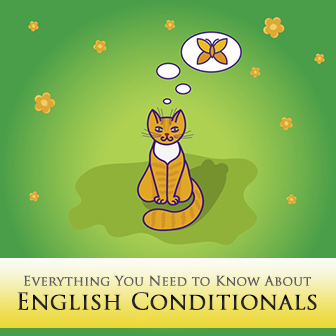Everything You Need to Know About English Conditionals: When the Present Isnít and the Past Wasnít


The unreal and real conditionals (sometimes referred to as First and Second conditionals) are an important part of academic language: the conditional is the way we speak about possibilities or probabilities. The third conditional is used to discuss the past.
First conditional or “real” is used for situations that seem real, at least in the writer or speakers’ mind: “If it rains, I will stay home.”
Second or “unreal” shows a less real possibility: “If it ever snowed in Los Angeles, I would ski.” The first discusses a real possibility for Los Angeles; the second a highly improbable one.
Third or past conditional portrays an unreal situation related to the past: “If I had known you were coming, I would have cleaned house.”
Hilary Clinton might say, “If I become president, I will end the war.” (Hillary Clinton has a real possibility of being president of the United States, at least in her mind at the time of speaking.)
A student in your class might say, “If I became president, I would end the war.” (Your student doesn’t see becoming president as a real possibility.)
A lot of what we discuss, especially in academic language, is the hypothetical, so it is important for students to know this how to use conditionals to discuss possibilities and probabilities.
Conditionals also have different pragmatic functions, such as to give advice or warnings:
“If I were you, I wouldn’t do that.” (second conditional)
Conditionals can also be used as politeness markers:
“Would you be so kind as to shut the door?’
“I would appreciate it if you wouldn’t smoke.”
Finally, they are used to express regret:
“If I had finished work earlier, I would have gone to the movie.”
All of these uses of the conditional—to discuss possibility/probability, give advice, express politeness, and show regret—are highly relevant to language learners.
Awareness:
Start by raising consciousness of conditionals. Notice the use of conditionals in an academic reading. Call students’ attention to them and discuss why the author used the conditional there.
Matching exercises:
Match the first part of a conditional sentence with its logical mate: “If it rains—“ and “I will take an umbrella.”
Student surveys:
Students can survey each other about what they will and would like to do in the future, contrasting two kinds of conditionals.
Wish Lists:
Emphasizing the unreal conditionals, students can interview each other and make up wish lists for their partners.
Requests:
Students can practice making polite requests of each other and role-play them, using the conditional. For effect and practice, they may exaggerate the politeness: “Would you be so kind as to lend me your pencil?”
Advice columns:
Students can write letters of advice to each other or famous figures, such as the president, using the conditional.
Journals:
Students can write journal entrees about plans and dreams for the future, using both the real and unreal conditionals.
Probability Discussions:
Guess the probability of certain events, using the conditional: whether or not it will rain on the weekend, if the war will end, for example.
Music:
Play the song “If I Were a Rich Man” from the musical “Fiddler on the Roof” or show a video clip. Discuss what the character Tevye would do if he were rich. Have students interview each other and write about what they would do if they were rich.
My Regrets:
For more advanced learners, introduce the third conditional, the past conditional. Have students discuss their regrets to practice.
Teaching the conditional can be labor-intensive but worth the investment of time and effort because in learning it, students not only develop academic writing ability but also their pragmatic abilities in expressing possibility, politeness, and regret. See our free lesson materials here: first conditional worksheets, second conditional worksheets, third conditional worksheets, zero conditional worksheets.
How do you teach Conditionals? Please share your tips in the comments below!